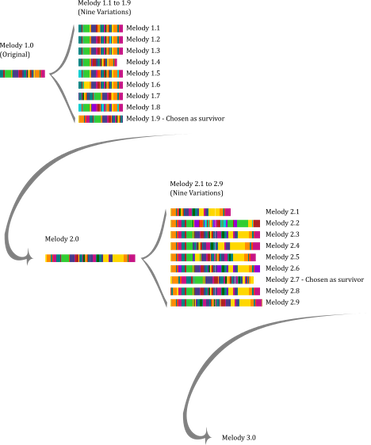EVOLUTIONARY MUSIC
Evolutionary Music was a collaboration with musician/composer Luke Cissell. In 2017, he recorded and released the music that evolved from the project, Mutatis Mutandis, on his album, Sonata for Viola and Piano--Three Piano Pieces.
Through the process of evolution, Nature creates interesting life forms. I was curious to see if a similar process could be used to create music. I invited the American composer, Luke Cissell, to join me. He wrote the following melody to start the process.
In the diagram below, it is called Melody 1.0. The different colours represent different notes, making the mutations easier to track. I created nine variations (1.1 to 1.9) by changing it a tiny bit, just as DNA is mutated during evolution.
|
Below is a list of the types of changes (mutations) I made to the music. In keeping with biology, I made them in a (more or less) random way.
1. inversion--a chunk of music (say 5-10 notes long) reverses in the right/left sense
2. missense mutation--alteration of a single note 3. deletion--one or several notes go silent 4. frameshift--a chunk of music shifts up or down a semi-tone (At the level of DNA, it's no more interesting than a small insertion or deletion but it has major downstream effects on the proteins.) 5. translocation--a chunk of music moves from one part of the music to another 6. insertion of viral DNA--a chunk of music from another piece of music gets inserted 7. methylation--a chunk of music gets peppered with sharps and flats 8. duplication--a chunk of music or single note gets repeated 9. repeat expansion--dramatic increase in the number of repeats in a section of music that is already repeated twice in succession 10. transposon insertion--a tiny fragment of music suddenly appears in more than one location in the music 11. nonsense mutations--alteration of a single note that causes termination of the music, not at that spot, but at some arbitrary point further on |
Luke chose and continued to work on the melody variation he found the most inspiring. Here it is, Melody 1.9.
He gave it back to me in its revised form (2.0) for another round of mutation. We continued handing the music back and forth like this. Finally, after multiple repetitions of the process--just as new species arise in Nature--the final piece, Mutatis Mutandis, evolved. Play a sample of the music, performed and recorded by Luke, below. Play the whole sample to get a sense of what happened!
Listen to the entire piece and more of his exquisite compositions by following him on Spotify.
He kindly provided this feedback on the project:
When Tia asked me to work with her on Evolution of Music, I was excited to get more of a look into the mechanics of this process of weaving order out of chaos. Working with Tia provided me not only with insight into the often sublimated decision-making that is happening in my own creative process, but also an opportunity to consider and incorporate changes, mutations, variations, and so on that I wouldn’t have arrived at on my own.
-Luke Cissell
When Tia asked me to work with her on Evolution of Music, I was excited to get more of a look into the mechanics of this process of weaving order out of chaos. Working with Tia provided me not only with insight into the often sublimated decision-making that is happening in my own creative process, but also an opportunity to consider and incorporate changes, mutations, variations, and so on that I wouldn’t have arrived at on my own.
-Luke Cissell
|
|
